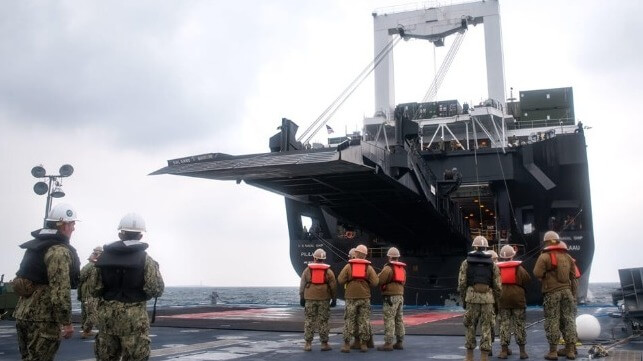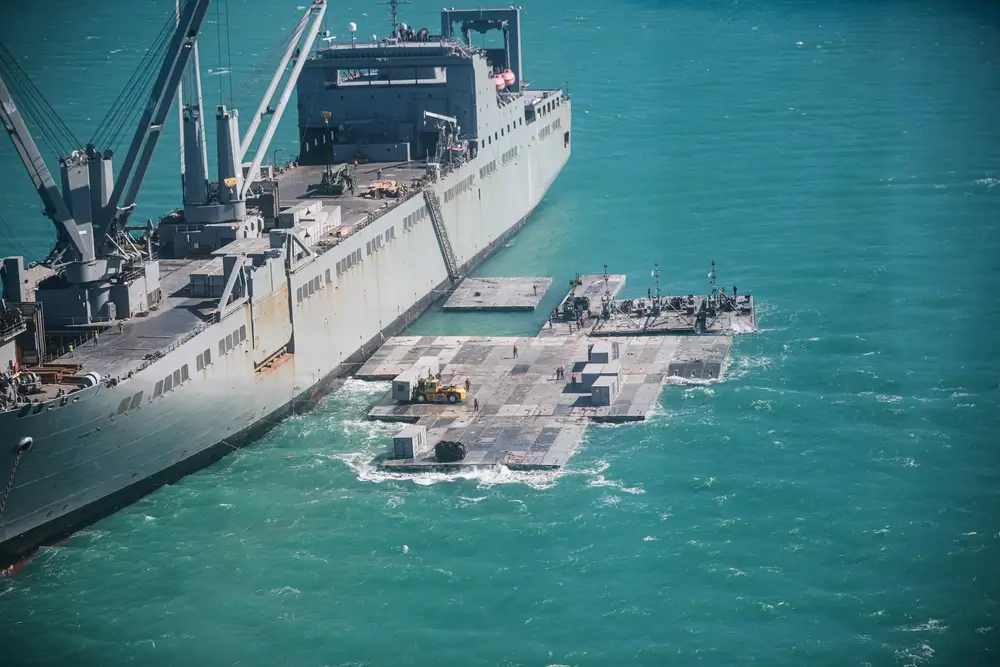U.S. Releases More Details of Floating "Port" for Gaza

The Pentagon has released new details of its plan to set up a temporary floating pier in northern Gaza, where food aid is needed to stave off an impending famine.
The logistical challenge is substantial. Gaza lacks any real seaports of its own, and its northern and eastern borders have been closed by the Israeli government. Aid trucks are currently allowed past the southern border checkpoints at a rate of about 200 per day, about 40 percent of the pre-conflict traffic volume.
To make up the difference, the U.S., the EU and the government of Cyprus have formulated a plan to set up a sealift corridor from Larnaca to northern Gaza. Since the territory lacks maritime infrastructure, U.S. Army and Navy forces will construct a mile-long floating causeway extending out from the beach into the open waters of the Mediterranean.

U.S. Navy and Army personnel assemble the end of a floating causeway offshore (USN file image)
Five U.S. Army landing ships departed Virginia earlier this month on a long transatlantic journey, and three Military Sealift Command cargo ships - USNS Roy P. Benavidez, 2nd Lt. John P. Bobo, and 1st Lt. Baldomero Lopez - are set to follow suit soon.
The deep-draft ships cannot pull up to the causeway directly, as the water alongside is still too shallow. Instead, they will offload their cargo onto a "roll-on, roll-off discharge facility," a barge-like modular platform measuring 72 feet wide by 270 feet long. This mini-dock will be stationed about three miles offshore and will receive aid cargoes.
Shallow-draft "causeway ferries" operated by Naval Beach Group 1 will take on the cargo, then shuttle it to the floating pier. At this point the aid will be offloaded and driven to shore. The overall system should have enough capacity to deliver two million meals a day.
The Joint Logistics Over The Shore (JLOTS) causeway system is a joint Army/Navy capability, supported by Seabees, Sealift Command civilian mariners and U.S. Army mariners (the Army's term for its maritime servicemembers). It should be operational within 60 days, according to the Pentagon - though Cypriot officials have hinted that it could be in service sooner.
"Our capabilities mesh well, and we have already coordinated at the tactical level how we will implement the movement of cargo," a Navy official said. "This is a routine mission for us, and we're just falling in together in step."
One challenge could be shoreside security. The White House insists that there will be no need for U.S. troops to step foot on shore, and Israel has agreed to provide needed security on the ground. However, Israel has quietly floated the idea of hiring in a private security contractor to fulfill that service, potentially using U.S. nationals serving as guard contractors, White House officials told NBC. The Biden administration is concerned at the prospect of having American civilians on the beach in Gaza and has objected to this plan.
No comments:
Post a Comment